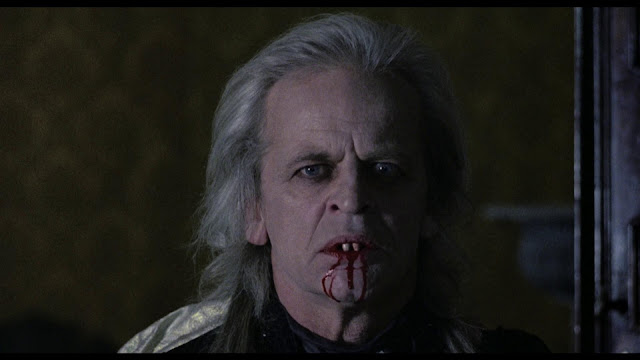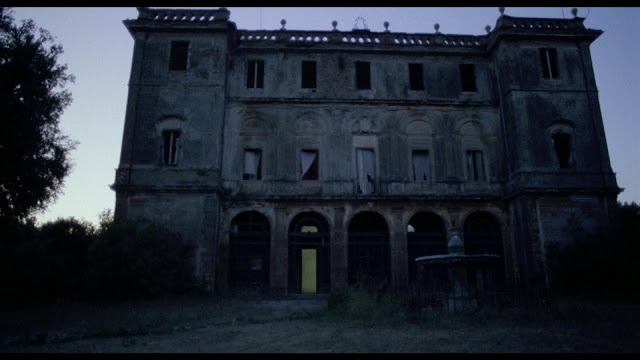NOSFERATU IN VENICE (Nosferatu a Venezia, 1988, 93:07, Severin Films)
Almost a decade after the release of Werner Herzog's NOSFERATU THE VAMPYRE (1979), Italian producer Augusto Caminito thought it would be a good idea to hire its erstwhile star Klaus Kinski to lend his presence to a belated sequel. He envisioned the film as being set in Venice at the time of its annual masquerade ball, a tradition dating back to the 14th century, when natives and tourists alike don masks and costumes of a bygone era, a time when Nosferatu would have walked its streets as one of the living.
Kinski did not arrive in time for these festivities; an omen of things to come. While waiting for his star, the initial director Maurizio Lucidi focused instead on this colorful celebration lending life, color, and surreal imagery to the greyest of European cities, working in additional shots of Kinski double decked out in his old Nosferatu makeup and creeping over the canal on the Bridge of Sighs. All this preparation was thwarted when Kinski finally did arrive and made it clear that he wasn't about to suffer again as he did on the Herzog film; he would wear the fangs but he was not going to cut his beautiful long hair, or be colored blue, or wear any other excessive makeup. He and Lucidi quickly reached a point of no return, forcing Caminito to choose the apoplectic truant over a director who had more than lived up to his contract by salvaging the first few days of production when Kinski couldn't be bothered to attend. Kinski, you see, had a "pay or play" contract and was working for roughly half the film's budget; simply put, there was no movie without Kinski. A replacement director, Pasquale Squiltieri, attempted to level the books by bringing in Christopher Plummer and Donald Pleasence at additional great expense, but again there were problems between Kinski and Squiltieri, who became the second director to be let go with full pay. The film's direction was then taken over by Mario Caiano, who abandoned the picture, again with full pay, upon learning that Caminito had told Kinski that he could direct his own scenes.
And you thought making movies might be fun.
As one watches NOSFERATU IN VENICE, there is no mistaking that it's some kind of disaster, but it's a tribute to Caminito and his editor Claudio Cutry (THE CURSE, CURSE II: THE BITE, BEYOND THE DOOR III) how acceptably this wet mess holds together. On Severin Films' new region-free Blu-ray release, we not only get the film but also a feature-length documentary about the final years of Kinski's career (ranging from CRAWLSPACE and CREATURE through NOSFERATU IN VENICE to his last film, PAGANINI, which he also directed) which is devoted almost entirely to outrageous accounts of his on-set behavior.
The movie begins, of course, with a duck hunt. The hunters look remarkably out of place, less like actual sportsmen than the dignitaries of the crew, which is exactly what they are. (Caminito is recognizable among them.) As they fire their rifles at a flock of flying ducks, a snippet of hair sticks dead center in the frame for so long that I began to think it was intentional, somehow part of the burgeoning plot. Somehow, one of the hunters - Dr. Barneval (Yorgo Voyagis) - shoots a bat, which falls at their feet and is declared to be bad luck.
A different kind of hunter, Professor Paris Catalano (Plummer, trying his best) arrives in Venice at the request of a noble Venetian family, the Canins. They have a well-locked tomb in their cellar they fear may contain the remains of Nosferatu (here used preposterously as an actual surname, as opposed to a genus), traced back as far as ten centuries ago, who mysteriously disappeared in Venice during its 1786 carnival. There is a dinner attended not only by the Princessa Maria Canins (Maria Cumani Quasimodo, excellent) and her beautiful daughter Helietta (Barbara De Rossi), but Don Alvise (Pleasence, a priest who safeguards their villa with baleful utterances), and Dr. Barneval and his attractive daughter Ute (Elvira Audrey). I'm foggy on whether Barneval or Catalano is introduced as "the world's foremost authority on vampirism," but the dinnertime conversation doesn't exceed what any kid picks up from watching old movies on television; at the same time, it extensively rewrites what we know of the subject. When Helietta asks how one becomes a vampire in the first place, Catalano answers, “By being the illegitimate son of illegitimate parents, the son of witches and warlocks, a man who takes his own life, those who die by hanging, those who die of the plague, those who die with blasphemy on their lips, murderers who die unpunished. And the descendants of vampires.” We also learn later in the film that a vampire "sleeps twenty-four hours every twenty-four days." Unlike most vampire films only make such new rules to avail themselves of them, none of this stately blather ever becomes useful later.
After dinner, everyone retires downstairs to the heavily bolted crypt (cue the wheezing synths of Luigi Ceccarelli) and Catalano announces that Nosferatu cannot be at rest there, as he was last seen shipwrecked somewhere off the sea of Biscayne. Catalano is attracted to a painting of the Princess Letizia, Helietta's distant ancestor and near twin. It is signed by the artist Utarefson, and Catalano - man-on-the-spot that he is - quickly produces a pocket mirror to confirm his suspicions of the artist's identity. In search of answers, they summon a medium (Clara Colosimo, dubbed by Carolyn De Fonseca) who determines that an attempt was made in 1786 to exorcise Nosferatu within the very walls of the Villa Canins. We see flashbacks to the occasion (“In the name of the Father and the Son and the Holy Ghost, I annihilate you!”) and Dr. Barneval, the voice of reason, scoffs. "Oh, come on, professor," he is scolded. "This is just harmless entertainment. No one is making you take part."
Twenty minutes into the picture, after we see the hapless exorcist impotently excoriating the bloodsucker before plunging to his death on the iron spikes of a fence outside the villa, Nosferatu finally bursts out of his resting place in what we can only presume to be modern day, whatever that is. He makes a pointless visit to a camp of dancing gypsies who seem to know him. ("Time has no meaning in a life that never ends," he says before drifting away.) He then voyages on to Venice by self-propelled gondola.
Meanwhile, the seance continues as the medium invokes the spirit of evil with a thesaurus-worth of labels for her adversary ("Incarnation of Iniquity! High Priest of Putridity! Enemy of Christ...") Meanwhile elsewhere, Nosferatu supposedly arrives at the height of Masquerade, allowing the production to make some use of the footage Kinski queered by his absence. He doesn't look like Nosferatu, but rather like a puffy, pink, somewhat sickly version of the vampire Lestat with heavy mascara and hair that wouldn't look out of place in the band Whitesnake. In counterpoint cutaways to our hero (who specializes in reading antique Latin texts aloud), we learn that the only way to destroy a vampire is with "the love of a consenting virgin." (Did they know how to bait Kinski or what?) Later, they hastily amend this limited list of combatitives with mercury, found amid the ashen remains of one of Nosferatu's past victims and thus "the only known element capable of killing a vampire." Nosferatu continues killing off the unnecessary cast members on the Villa's handy spiked iron fence but is stopped in his tracks by the beauteous Helietta, in whom he recognizes the reincarnation of his lost Letizia. He goes to Helietta's bed where, in real life, Kinski got too personal with his co-star Barbara De Rossi, causing her to flee the stage in tears. She may have also refused to work with him any further because, from this point on, our frisky proponent of "love never dies" turns his gropey attentions to Helietta's sister Maria (Anne Knecht, the real-life girlfriend of Yorgo Voyagis, an untrained actress whom Kinski "insisted" take over the female lead).
Adding interest to the third act is Nosferatu's race to the refuge of the derelict Villa Grazioli in Frascati, the same location used for Villa Graps in Mario Bava's 1966 masterpiece KILL, BABY... KILL! (This is the last time it would be seen in the derelict condition it had fallen into during the war, as its restoration to its original beauty was undertaken in the year of this film's release.) Dr. Barneval goes into battle armed with a rifle (“It can stop a charging rhinocerous. Its muzzle velocity is incredible.”) which blows a perfect hole in Kinski, an effect apparently achieved by having Kinski wear a mirrored medallion. Ultimately, Catalano prevails uttering these bitter words: "How ironic. What a waste. To think that the end of one’s life’s work to discover the arrogance of opposing evil in one's own way, is perhaps the universal scheme of God." Plummer's sudden exit from the film behind a gust of Venetian fog is hilariously similar to Bela Lugosi's exit in PLAN 9 FROM OUTER SPACE.
For all its shortcomings, NOSFERATU IN VENICE shares a good deal of the off-center flavor and ambiance of some of Lucio Fulci's later work, which is to say that, even if the production had gone more smoothly, it may have not been too different to what we have, as it reflects the the diminishing standards of the Italian exploitation cinema at that time. Sad to say, but its absurdity is its primary charm. The quality of the scenery is a given. Another of its quirky pleasures is the outrageously stilted, prosaic dialogue; if you watch the English dub (the prefered soundtrack as it retains most of the film's vocal performances) with the English subtitles activated, you'll see that its strings of similes and overinflated platitudes read much better than they play. This is through no fault of the performances; it is because Caminito either didn't know how, or had no intention, to make use of realistic dialogue. Its mad grandiosity somehow melds well with the Venetian scenery, which cameraman Tonino Nardi captures in all its damp mystery. The cheap synth score, which purports to be based on music by Vangelis, is nothing I can imagine anyone rushing out to buy.
Of course, Klaus Kinski and Donald Pleasence have been gone for awhile, but we just lost Christopher Plummer earlier this year. This feels like a still recent film - it hasn't dated visually in any way - and to see Plummer here, still looking young and virile (if a bit morbidly obsessed) and drawing breath with his co-stars, drives home the sober fact that time is marching on despite all appearances. Though the film retains a certain freshness in spite of itself, it really does belong to another time. Both English and Italian soundtrack options are provided with optional English subtitles.
Subscribe to Tim Lucas / Video WatchBlog by Email
If you enjoy Video WatchBlog, your kind support will help to ensure its continued frequency and broader reach of coverage.









